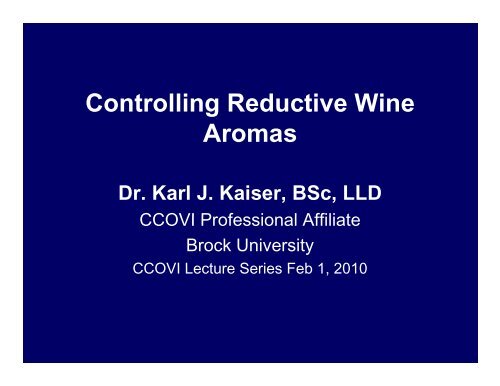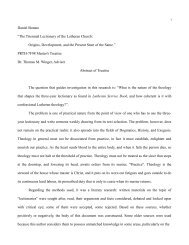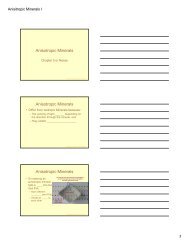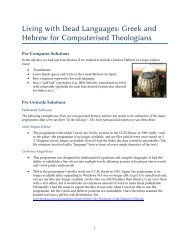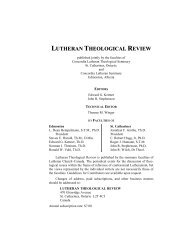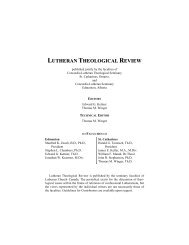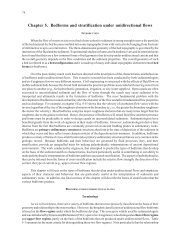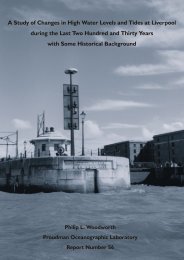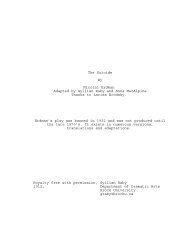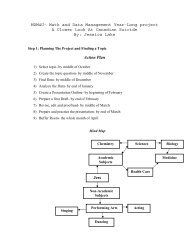Download slideshow presentation - Brock University
Download slideshow presentation - Brock University
Download slideshow presentation - Brock University
You also want an ePaper? Increase the reach of your titles
YUMPU automatically turns print PDFs into web optimized ePapers that Google loves.
Controlling Reductive Wine<br />
Aromas<br />
Dr. Karl J. Kaiser, BSc, LLD<br />
CCOVI Professional Affiliate<br />
<strong>Brock</strong> <strong>University</strong><br />
CCOVI Lecture Series Feb 11, 2010
Wine Defects of Minor and Major j<br />
importance<br />
• Acetic acid (vinegar) (vinegar), acetaldehyde (leafy (leafy,<br />
cherry), acetate esters (solvent); butyric acid<br />
(rancid); ethyl acetate (nail polish remover);<br />
ffermentation t ti esters t (banana), (b ) geranium i<br />
(flowery); lactic (sauerkraut); leesy (baked<br />
bread); ) mousey y ( (pungent); g ) bottle shock<br />
(aromatically neutral); oxidation; lack of varietal<br />
character; filter pads; excess sulfite, horsey<br />
(barnyard); ( y ); diacetyl y (buttery); ( y); alcoholic; ; corky y<br />
(musty, moldy)<br />
• Hydrogen sulfide (H2S) – Rotten egg smell<br />
• Mercaptan – bburnt rnt rrubber, bber garlic smell
Reduced Wines – The Most Common<br />
PProblem bl in i Winemaking<br />
Wi ki<br />
What causes it?<br />
• Sulfur is reduced to hydrogen sulfide (H2S) What is Oxidation-Reduction?<br />
• Oxidation is the process in which an atom loses<br />
electrons and undergoes an algebraic increase in<br />
oxidation number<br />
• Reduction is the process in which an atom gains<br />
electrons and undergoes an algebraic decrease in<br />
oxidation number<br />
• When there is an oxidation at one atom or molecule,<br />
then there is always a reduction in the other
Oxidation and Reduction<br />
When Sulfur is oxidized:<br />
S0 O 0 S4+ O 2<br />
S0 + O 0<br />
2 → S4+ O2<br />
2-<br />
ie. S 0 (sulfur) is oxidized to S 4+<br />
O 2 0 (oxygen) is reduced to 2O 2-<br />
When Sulfur is reduced:<br />
S 0 + H 2 0 → S 2- H2 +<br />
i S0 ( lf ) i d d t S2 ie. S0 (sulfur) is reduced to S2- H 2 0 (hydrogen) is oxidized to 2H +
Oxidation and Reduction<br />
However, in often simplified language, we<br />
generalize:<br />
• Oxidation means the addition of oxygen<br />
and reduction is the addition of hydrogen<br />
• The structure of H H2S S is similar to the<br />
structure of water H2O S O<br />
H H H H
Hydrogen Sulfide: H H2S 2S<br />
• Also called “sulfur hydride” y or “sulfone”<br />
• Common other names are “rotten egg gas”,<br />
“sewer gas”, “volcanic gas”, “sour gas” and “stink<br />
damp” damp<br />
• H2S is highly toxic and its toxicity is comparable<br />
to hydrogen cyanide (HCN)<br />
• H2S was responsible for the “great Permian<br />
Mass Extinction” according to one theory (versus<br />
the t e impact pact theory) t eo y) 251.4 5 million o yea years s ago<br />
• One naturally finds H 2S present in well water as<br />
well as in deep ocean volcanic vents
Recognition and detection<br />
thresholds h h ld for f H 2SS<br />
• The LD 50 for H2S 2 in air is 800 ppm pp<br />
• The recognition threshold in air is 4.7 ug/L or 4.7<br />
ppb (= 4.7 X 10-6 g/L)<br />
• The detection level in air for most people is 22.0 0<br />
ug/L or 2.0 ppb (=2.0 X 10-6g/L) • In Wine, , the flavour threshold is reported p as<br />
– 50-80 ppb (Wenzel et al, 1980)<br />
– 20-30 ppb (Dittrich and Staudenmayer, 1968)<br />
• Today we use 30 30-50 50 ppb as the benchmark benchmark, but<br />
temperature, pH, alcohol, etc can affect the<br />
detection level
Reductions in Wine<br />
11. Hydrogen sulfide: S + H H2 → H 2S S (rotten egg)<br />
• M.P. = -85.0 °C<br />
• B.P. = -60.7 °C<br />
22. Mercaptan: if H H2S S in wine is not removed from the<br />
wine, it can (will) react with ethanol or acetaldehyde to<br />
form a new, even nastier compound called ethyl<br />
mercaptan or ethanethiol (burnt rubber, garlic,<br />
cabbage)<br />
eg 3CH3-CH2OH + 3H2S → 3CH3-CH2-SH + 3H2O • M.P. =-148°C 148 C<br />
• B.P. = +35°C<br />
Mercaptan in wine is very persistent and hard to get rid of<br />
because of the higher g B.P.<br />
Sensory threshold in wine is 0.02-2.0 ppb<br />
In 2000, the “Guinness Book of World Records” lists<br />
ethanethiol as the “smelliest smelliest substance in<br />
existence” (at 2.8 ppb)
Special Caution<br />
• H2S 2 in a new wine where malolactic<br />
fermentation (MLF) and prolonged lees contact<br />
is intended and the wine will not been sulfited<br />
(free ( aldehydes) y ) for weeks or months some of<br />
the H 2S will likely react with the ethanol and/or<br />
acetaldehyde to form ethyl mercaptan<br />
• ee.g. g barrel fermented Chardonnay
Reductions in Wine continued<br />
3. Diethyl y disulfide: if ethyl y mercaptan p is not<br />
eliminated, then two molecules of mercaptan<br />
can react to form another molecule, even more<br />
nasty<br />
CH3-CH2-SH + HS-CH2-CH3 →<br />
CH3-CH2-S-S-CH2-CH3 M.P. = ?<br />
B.P. = +154°C (very non-volatile)<br />
• This molecule is almost impossible to eliminate<br />
from wine (by normal means) and has a very<br />
cheese-like aroma
Historical measures to either avoid<br />
or eliminate li i t H 2S S and d mercaptans t iin<br />
wine<br />
1. During Winemaking, to avoid it<br />
• Put a late copper spray on the grapes (copper sulfate<br />
or copper oxychloride) hl id )<br />
• Add copper sulfate to the juice or fermenting wine<br />
(Australia)<br />
• Use copper alloy (bronze, brass) fittings in the cellar<br />
and in machinery<br />
– Bronze = copper + tin<br />
– BBrass = copper + zinc i<br />
• Install copper tubing (pipe) where the wine can be<br />
pumped through it in the cellars
Elimination strategies<br />
22. Once you have it<br />
• Aeration<br />
• SSulfiting lfiti<br />
• Copper sulfate fining and blue fining<br />
• Copper citrate<br />
• Silver chloride
Eliminating Hydrogen Sulfide<br />
Aeration<br />
• The simplest way sometimes is to aerate since H2S has<br />
a low B.P. of f only -60.7°C °C<br />
2H2S + O2 → 2S + 2H2O • Aeration will also oxidize any present Cu + to Cu ++<br />
Aeration will also oxidize any present Cu to Cu<br />
Sulfiting<br />
• Frequently a sulfiting eliminates H2S 2H2S + H2SO3 → 3S + 3H2O (Sulfur dioxide (sulfiting) added in aqueous solution is H2SO3) • Most ost ooften te ae aeration at o in co combination b at o with t su sulfiting t g ggives es<br />
the best results; and sulfiting also protects the wine<br />
simultaneously from oxygen causing other oxidation<br />
problems
Eliminating Hydrogen Sulfide<br />
Copper Sulfate additions<br />
H H2S S+CuSO + CuSO .<br />
4 5H 5H2O O → CuS + H H2SO SO3<br />
• Copper sulfate can react with hydrogen sulfide and<br />
slowly with mercaptans (several days), but not<br />
di diethyldisulfide<br />
th ldi lfid<br />
– The wine must be “clean” with no yeast present before addition<br />
• When copper pp sulfate is needed in excess of 2-3 mg/L g ( (ie<br />
0.5-0.75 mg/L as copper), then one has to “bluefine” with<br />
potassium ferrocyanide to remove any excess copper<br />
• K4[Fe(CN) 6] . K4[Fe(CN) 6] 3H 3H2O 2O (yellow prussiate)<br />
• Copper sulfate and Potassium ferrocyanide (blue fining)<br />
will barely work with diethyldisulfide because the sulfur in<br />
the disulfide linkage will not easily bind to the copper
Eliminating Hydrogen Sulfide<br />
Other problems with potassium ferrocyanide<br />
• If there is little or no iron (Fe) in the wine as we<br />
now have stainless steel equipment, the “blue<br />
fining” will hardly work well to remove the excess<br />
copper pp from the wine if one had to use in excess<br />
of 2-3 mg/L of copper sulfate for fining<br />
• In order to get good flocculation of the “prussian<br />
blue” blue precipitate from the potassium<br />
ferrocyanide, one needs to add simultaneously<br />
during blue fining a gelatin/silica gel agent,<br />
which may also strip the wine<br />
• To be certain no cyanide is left in the wine, the<br />
Hubach Test must be performed for cyanide y<br />
residues
Eliminating Hydrogen Sulfide<br />
Copper pp Citrate<br />
• Copper(II)-citrate is a new compound<br />
(Cu .<br />
2C6H6O7 2.5H2O)<br />
• RRecommended d d iinstead d of f copper sulfate lf since i it i<br />
is an “organic chelating agent” of copper<br />
meaning g the copper pp does not totally y ggo<br />
into the<br />
ionic form. Consequently, it does not leave as<br />
much residual copper in the wine<br />
• The manufacturer claims only about 50% goes<br />
into wine<br />
• This is not legal in Canada yet
Wine Treatment Agents<br />
Agent Formula Composition Notes<br />
Copper Sulphate CuSO 4 x 5 H 2 O 25.5 % Copper 1 g = 255 mg<br />
copper<br />
Copper Citrate Cu2C6H4O7 x 2.5 35 % Copper 1 g = 350 mg<br />
H H2 O copper<br />
Kupzit Cu 2 C 6 H 4 O 7 x 2.5 2 % Copper 50 g Kupzit = 1 g<br />
2 6 4 7<br />
H 2 O in Bentonite Citrate copper citrate =<br />
350 mg copper
Eliminating Hydrogen Sulfide<br />
Silver Chloride (AgCl)<br />
• Works like a charm<br />
• Silver preparations (“sulfidex”) were permitted in<br />
Europe, typically bound to diatomaceous earth<br />
and/or fixed onto filter pads<br />
• It worked for H2S and mercaptans and<br />
diethyldisulfide<br />
• It left no silver in the wine and therefore, no<br />
additional blue fining was necessary<br />
• It is no longer permitted in Europe because<br />
silver is considered a “heavy metal” compound<br />
but will it still be allowed in other countries????<br />
We don don’t t know know.
Wine Treatment Agents<br />
Treatment Impact on Wine<br />
Copper Sulphate •Increased copper content<br />
•Bitter flavour<br />
•Possible cloudiness (casse) ( )<br />
•Blue fining possibly required<br />
Silver Chloride (bound to diatomaceous •Increased silver content<br />
earth) •Bitter flavour<br />
•Possible cloudiness<br />
•Blue fining possibly required<br />
Copper Citrate (Cupric Citrate)<br />
Copper is chelated to citric acid which is<br />
bound to bentonite as a carrier<br />
•Low increase of copper content<br />
•Lower probability of blue fining<br />
•Can easily be filtered out
What is the cause of H 2S<br />
production (reduction of wine)<br />
-the relationship to nitrogen<br />
• There is a link between low nitrogen values in<br />
juice and hydrogen sulfide production during<br />
ffermentation—more t ti tto come shortly h tl<br />
• During fermentation, yeast metabolizes nitrogen,<br />
ie it needs nitrogen badly<br />
• This needed nitrogen has to come from the<br />
medium, , the grape g p jjuice<br />
• It is present in the form of ammonia (NH3) (small<br />
amounts) and is present in a bound form in the<br />
amino i acids id (there (th are about b t 20 amino i acids)<br />
id )
Measuring g Juice Nitrogen g<br />
• This nitrogen from ammonia and amino acids<br />
can bbe analyzed l d ffor and d iis expressed d as<br />
Ammonia Nitrogen (mg N/L) and Free Amino<br />
Nitrogen (FAN) (mg N/L)<br />
• The sum of both is expressed as Yeast<br />
Assimilable Nitrogen Concentration (YANC)<br />
(mg N/L)<br />
• We should remember that the FAN is not as<br />
easy for the yeast to extract and use<br />
• The yeast has to “work hard” to “pry off” the<br />
nitrogen from the amino acids
Yeast Nitrogen Usage<br />
• The ammonia nitrogen is very easily<br />
metabolized by the yeast<br />
• It is like “candy” candy for the yeast and the<br />
yeast prefers it since it can be immediately<br />
taken up p and used<br />
• The yeast needs nitrogen for the<br />
biosynthesis y of its cell mass and to<br />
perform other numerous biosynthetic<br />
reactions
Amino Acids<br />
• There are 20 amino acids<br />
• Arginine, Proline and Glutamine are the<br />
most abundant amino acids in grape juice<br />
for most varieties and vintages<br />
P li d L i i t ll t d<br />
• Proline and Lysine are virtually not used<br />
by the yeast as a nitrogen source
Amino Acids in grapes during ripening<br />
Sponholz, Intl.<br />
Symposium on<br />
Nitrogen in<br />
grapes and<br />
wine, 1991
Ammonia and Amino Acid Usage<br />
PPreference f by b Yeast Y<br />
Most Preferred N sources<br />
• Ammonia: is not very abundant in grape<br />
juice<br />
• Glutamic Acid: is not so abundant in grape<br />
jjuice i but b t is i a preferred f d N source<br />
• Glutamine: is quite abundant in grape<br />
juice and is a preferred N source
Ammonia and Amino Acid Usage<br />
PPreference f by b Yeast Y<br />
Next most preferred p N Sources<br />
• Since arginine is so abundant, the yeast will also<br />
readily use it, but it is a moderately preferred N<br />
source ffor<br />
yeast<br />
• Excess of arginine in grape juice (over 1000<br />
mg/L) is not desirable since it can release urea<br />
when yeast metabolize it, and the urea reacts<br />
with ethanol to form ethyl carbamate<br />
(carcinogenic compound)<br />
• The federal limit of ethyl carbamate is 30 ppb but<br />
the LCBO allows only 20 ppb at the time of<br />
bottling
Wine Ethyl Carbamate levels pre-<br />
1980 vs post 1980<br />
Sponholz, Intl. Symposium on<br />
Nitrogen in grapes and wine, 1991
Grape Juice Nitrogen in Niagara musts<br />
(Drought) (Rainy)
Nitrogen Values in NY Musts
Amino Acids in must before and<br />
after f BBotrytis i Infection I f i<br />
Sponholz, Intl.<br />
Symposium on<br />
Nitrogen in grapes<br />
and wine, 1991
Influence of Nitrogen Fertilization on<br />
AAmino i AAcid id composition iti in i GGrapes<br />
Sponholz, Intl.<br />
Symposium<br />
on Nit Nitrogen in i<br />
grapes and<br />
wine, 1991
Yeast Sulfur Metabolism<br />
Sources of Sulfur compounds<br />
• Both organic and inorganic sulfur compounds<br />
are present p in ggrape p jjuice and can be utilized by y<br />
the yeast<br />
Inorganic Sulfur in grapes/juices<br />
Sulfate (SO 2- • Sulfate (SO 2-<br />
4 )<br />
• Sulfite (SO 2-<br />
3 ) from addition of SO2<br />
• Elemental Sulfur (S8 Elemental Sulfur (S ) from spray residues<br />
– In Ontario, 21 day preharvest interval for S sprays<br />
Organic Sulfur in grapes/juices<br />
• Predominantly S- containing amino acids<br />
cysteine and methionine<br />
• Less dominant are the vitamins thiamine and<br />
biotin
Factors Effecting H H2S 2S Formation
Sulfate Reduction Sequence in making<br />
sulfur containing amino acids<br />
• During fermentation, sulfur compounds can be reduced<br />
to hydrogen sulfide by the sulfate reduction sequence<br />
(SRS) if the yeast needs it to make cysteine and<br />
methionine<br />
• In the absence of acceptor molecules (organic nitrogen<br />
compounds) for the sulfide when the SRS is triggered,<br />
the hydrogen sulfide is released into the wine from the<br />
yeast<br />
• In order for the yeast to scavenge the hydrogen sulfide<br />
and incorporate it into cysteine and methionine, the<br />
yeast y need plenty p y of nitrogen g<br />
• If the yeast does not need to make cysteine and<br />
methionine because it is available in the grape juice,<br />
then they do not trigger the SRS to make the sulfide
Sulfate Reduction Sequence:<br />
the path to make SS-amino amino acids<br />
Cysteine<br />
Methionine
Yeast Nitrogen g Metabolism<br />
• Nitrogen is the second most important<br />
nutrient for the yeast biosynthesis after<br />
carbon<br />
• A great majority of the nitrogen comes<br />
from the degradation of amino acids<br />
– 60-90% 60 90% comes from only 8 amino acids<br />
(Kliever, 1969)<br />
• This is called FAN (free ( amino nitrogen) g )<br />
• Ammonia is preferred but is less abundant<br />
in grape g p jjuice
YANC-Yeast Assimilable Nitrogen<br />
Content<br />
• Not all grape varieties have the same YANC<br />
content, varies by location as well<br />
• The weather (season, ( , rain vs dry) y) in a particular p<br />
year has a large impact on YANC (both<br />
Ammonia and FAN)<br />
– Previous table from Niagara showed in a dry year, the<br />
YANC values were much lower (2007) than in a wet<br />
year (2008)<br />
– Eg Chardonnay: Only 55 mg N/L in 2007 vs 325 mg<br />
N/L in 2008<br />
– Importance of measuring must nitrogen values
The Effect of Drought vs Rain on Must N<br />
(Drought) (Rainy)
YANC-Yeast Assimilable Nitrogen<br />
Content<br />
• Vineyard fertilization will also influence the<br />
FAN/YANC in the juice, both in terms of<br />
total abundance and in composition<br />
(previous table)<br />
– Remember the trouble when a lot of wines<br />
had defects because of nitrogen starvation in<br />
the vineyards y ( (Atypical yp Aging, g g, ATA) )<br />
– 50-90 kg of N/Ha is accepted in CA, excess<br />
nitrogen g will however cause excess vigor g
YANC-Yeast Assimilable Nitrogen<br />
CContent t t<br />
• Cropping levels in the vineyard have a<br />
significant i ifi t iinfluence fl on th the FAN/YANC content t t<br />
– High cropping will produce a shortage of YANC<br />
• With an increase and adequate YANC levels levels,<br />
there is a great increase in ester formation<br />
(aroma) during fermentation (A. Rapp and Q.<br />
Versini, 1984/85)<br />
• With a shortage of YANC, there is low ester<br />
formation (ie can lead to lack of varietal aromas<br />
and strange off aromas develop in the bottle)<br />
– ATA-atypical yp aging g g<br />
– UTA-untypical aging (Rapp and Versini)
YANC-Yeast Assimilable Nitrogen<br />
Content<br />
• Bentonite fining g of the jjuice with 100g/hL g (1 ( g/L) g )<br />
may remove up to 30% of the amino acids<br />
– This consequently lowers the FAN which may result<br />
in a shortage g of “YANC”<br />
• The minimum required YANC to support yeast<br />
during fermentation accepted by researchers in<br />
model solutions is 150 mg N/L N/L, but this also<br />
varies with yeast strain<br />
• The preferred concentration of YANC to target is<br />
approx. 300 mg N/L<br />
• Most grape juices do not have this amount of<br />
YANC and some varieties are really short in<br />
certain years
H 2S Production as a<br />
CConsequence of f YANC Sh Shortage<br />
• If there is insufficient nitrogen g in the ggrape p jjuice,<br />
the yeast turn on the SRS pathway to make<br />
cysteine and methionine, the S-containing amino<br />
acids<br />
• The SRS pathway makes hydrogen sulfide from<br />
Sulfate<br />
• IIn order d for f the th yeast t tto scavenge th the hhydrogen d<br />
sulfide and incorporate it into cysteine and<br />
methionine, the yeast need plenty of nitrogen<br />
• If there is not enough organic nitrogen, the yeast<br />
release the hydrogen sulfide into the wine
Low Nitrogen leads to H 2S, ammonia<br />
supplementation reduces H 2S 2S<br />
Lots of H 2S when NH 3 gone<br />
NH 3<br />
getting<br />
used<br />
Ammonia addition, H 2S drops<br />
H2S 2S aga again<br />
when NH3 gone
Sulfate Reduction Sequence<br />
if low Nitrogen Nitrogen, sulfite can form H H2SS Adapted from Bell and<br />
Adapted from Bell and<br />
Henschke, AWRI 2005
The role of Sulfite in hydrogen sulfide<br />
production p when nitrogen g is limitingg<br />
H H2SS
Diammonium Phosphate: The Miracle<br />
compound p to avoid H2S 2 in wine<br />
• Diammonium phosphate (DAP)<br />
(NH4) 2HPO 2HPO 4 is a plant fertilizer as well as<br />
a yeast nutrient<br />
• 20% of the weight of DAP is nitrogen<br />
ie 1.0 g/L DAP added to juice = 0.2 g/L of Nitrogen<br />
(or 200 mg N/L from each 1 g/L of DAP)<br />
• The Bureau of Alcohol, Tobacco, Firearms and<br />
Explosives (ATF) in the US allows 1.0 g/L DAP<br />
• Th The Canadian C di RRegulations l ti stipulate ti l t now GMP<br />
(Good Manufacturing Practice) as the limiting<br />
condition for DAP addition
Diammonium Phosphate: The Miracle<br />
compound dt to avoid idHSi H2S in wine i<br />
• DAP will supplement the missing YANC needed<br />
to avoid H2S in wine<br />
• Yes, , it is an incredible tool to prevent p reduction<br />
of a wine (H2S and mercaptan formation)<br />
– It will supply, if added at the right time, the nitrogen<br />
needed to complete the necessary biosynthesis of<br />
organic S-compounds such as cysteine and<br />
methionine<br />
– This is necessary to “scavenge” the H2S produced by<br />
the Sulfate Reduction Sequence
Diammonium Phosphate: The Miracle<br />
compound dt to avoid idHSi H2S in wine i<br />
• If there is a shortage of Nitrogen to achieve the<br />
biosynthesis of cysteine and methionine, then<br />
the H2S will be released from the yeast into the<br />
wine and the wine becomes REDUCED<br />
• Even if there is already H2S in the wine in the<br />
early stages of fermentation due to a nitrogen<br />
deficiency, the addition of DAP will eliminate the<br />
H H2S S within a few hours from the wine
Recommended Application of<br />
DAP<br />
Two Stages<br />
• Stage One: to the juice at the start of fermentation, add<br />
50% of the amount of DAP into the fermenting vat<br />
• Stage g Two: at around 5% ethanol, add the remaining g<br />
50% of the DAP<br />
Single Stage<br />
• There is no negative effect if one adds the total amount<br />
at the beginning of the fermentation<br />
• Important to consider in barrel fermentations<br />
Beware<br />
• No DAP should be added once the alcohol reaches<br />
above 7% alcohol (the yeast can not take it up<br />
effectively, too late by then)
IMPORTANT MESSAGE<br />
• Whenever the yeast y runs out of nitrogen g during g<br />
the early stages of fermentation (i.e. when their<br />
biosynthetic pathways are most active), YOU<br />
WILL GET H 2S S – A REDUCED WINE- WINE SINCE<br />
THE SULFATE REDUCTION SEQUENCE IS<br />
TURNED ON<br />
• However, when there is enough nitrogen<br />
available for the yeast, the H2S, even though it<br />
may bbe made d bby th the SRS SRS, won’t ’t bbe released l d<br />
into the wine (it gets scavenged into S-amino<br />
acids). ac ds)
Practical considerations to cure<br />
minor reductive wine aromas with<br />
CuSO 4.5H 20<br />
We must keep p in mind that the<br />
• Federal law for copper in wine is 1.0 ppm (1 mg/L)<br />
– Changed in 2006<br />
• The LCBO’s limit (as well as most liquor jurisdictions) for<br />
copper in wine is 1.0 ppm (1 mg/L)<br />
• Note: WHO limit for drinking g water is 2 pp ppm and EPA limit is 1.3 pp ppm<br />
• Danger of COPPER CASSE<br />
Sometimes small amounts of copper (Cu2+ ) added can<br />
eliminate minor off smells of reduced sulfur compounds<br />
(H2S and mercaptan)<br />
The reaction of copper with H2S is fast the reaction of Cu2+ The reaction of copper with H2S is fast, the reaction of Cu<br />
with mercaptan takes time
Checking for H 2S or mercaptan<br />
in wine<br />
• Any wine checked correctly for reduced<br />
aromas must be clear and properly<br />
filtered filtered. No yeast or colloids may be<br />
present for a valid test
A. Simple p “Penny y Test”<br />
• Not a quantitative but rather a qualitative test<br />
• Sometime adding g a few ppennies<br />
to 50-100 mL of wine in<br />
a glass will show quickly if a wine is helped with copper<br />
when compared with another glass with no pennies –<br />
side by side<br />
• US Pennies: were until 1982 made of 95% copper + 5%<br />
zinc, today they are 97.5% zinc and 2.5% copper plating<br />
• Canadian Pennies: today they are 94% steel, 1.5%<br />
nickel, 4.5% copper plating<br />
( (since i the th copper plating l ti is i on the th outside, t id it is i exposed d to t<br />
the wine)
AA. Simple “Penny Penny Test Test”<br />
• If only H H2S 2S is present the wine will clean<br />
up quickly<br />
• If mercaptan is present the wine may<br />
clean up if left in contact for longer<br />
• It is i wise i tto lleave th the pennies i iin th the glass l<br />
for a while (up to several hours) to see if<br />
mercaptans t are presentt<br />
• This is a quick and easy test for reduced<br />
aromas
B. Test with a standard copper<br />
solution<br />
• With this method, , a much more analytical y and<br />
quantitative result can be attained<br />
• With this procedure, you can evaluate how much copper<br />
needs d tto be b added dd d tto eliminate li i t th the reduced d d aromas<br />
• In both tests (the penny and the standard copper<br />
solution test) the wine may need time to clean up if<br />
mercaptan is present<br />
• Remember mercaptan elimination is a slow process<br />
i th C 2+ since the Cu h t ff th HS f th th l<br />
2+ has to pry off the HS from the ethyl<br />
mercaptan molecule
Preparation of a Standard<br />
Copper Sulfate solution<br />
• Distilled Water - 1L (1000 mL)<br />
• Analytical grade CuSO 4.5H 2O - 2.0 g<br />
( t C SO 5H O 25% C 2+ (note: CuSO4.5H2O = 25% Cu ) 2+ )<br />
ie<br />
• 2.0 g CuSO 4.5H 2O/1000 mL water<br />
= 0.5 g Cu 2+ /1000 mL<br />
500 C 2+ = 500 mg Cu /1000 L<br />
2+ /1000mL<br />
=0.5 mg Cu 2+ /1 mL<br />
(1.0 g CuSO CuSO4.5H 4.5H2O/500 2O/500 mL water will give same concentration)
Quick Test using copper solution<br />
• 1 mL of this solution is 20 drops from an eyedropper<br />
eyedropper,<br />
which is 0.5 mg of Cu2+ Drops of solution Copper in 100mL Cooper<br />
of wine concentration<br />
1 drop 0.025 mg Cu 2+ /100<br />
mL<br />
0.25 mg Cu 2+ /L<br />
2 drops 0.05 mg 0.5 mg Cu2+ p g<br />
Cu<br />
/L<br />
2+ /100mL<br />
g<br />
3 drops 0.075 mg<br />
Cu 2+ /100mL<br />
0.75 mg Cu 2+ /L<br />
4 drops 0.1 mg Cu 2+ /100mL 1.0 mg Cu 2+ /L<br />
• Leave the 100mL samples for several hours on the counter or in<br />
fridge fridge, and then compare smell to control wine<br />
• If you see it has not cleared up the wine in this time period, then you<br />
would prepare 500 mL bottles or 1L bottles with the equivalent<br />
concentrations (0 (0.25, 25 00.5, 5 00.75 75 and 11.0 0 mg Cu2+/L) Cu2+/L), keep in fridge<br />
for 1 week to see if the mercaptans can be removed
Some Last Words<br />
• Research has shown that wine produced from clean juices have<br />
superior organoleptic properties<br />
– Approximately 0.1% solids<br />
• It is most important to ensure that YANC levels in juice and must<br />
is adequate q to avoid the SRS<br />
– 300 mg/L of YANC should be enough<br />
– Adding 1 g/L DAP will give 200 mg/L of added Ammonia<br />
• Check for H2S and mercaptan with the simple penny test if you<br />
have a suspicion<br />
• In the case that you find reduced aromas carry on using the<br />
standard copper sulphate solution<br />
• Approach pp the Federal Government to allow the use of cupric p<br />
citrate<br />
– Has been legal in many countries since 2006<br />
– Austria, Switzerland, South Africa, most of eastern Europe, and<br />
Australia and New Zealand (if ( bound to bentonite) )
THANK YOU<br />
Marc Pistor BB.Sc., Sc Inniskillin Wines Wines, for<br />
assistance in compiling the nitrogen data<br />
for the Niagara musts<br />
DDr. Debra D b IInglis, li CCOVI CCOVI, collaborator<br />
ll b t


